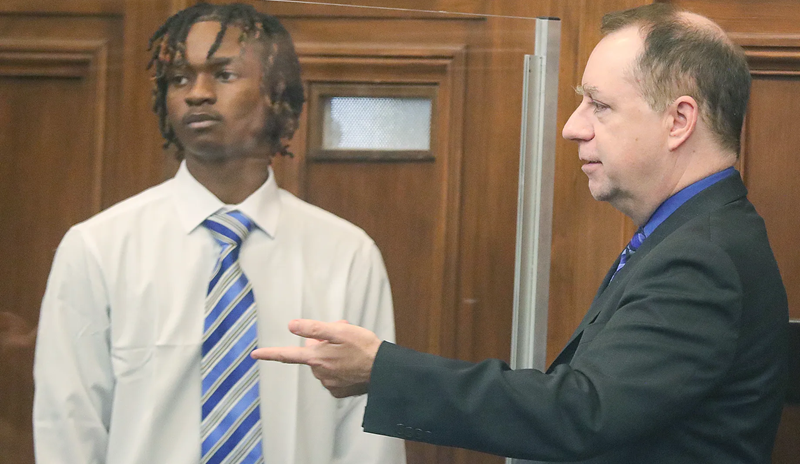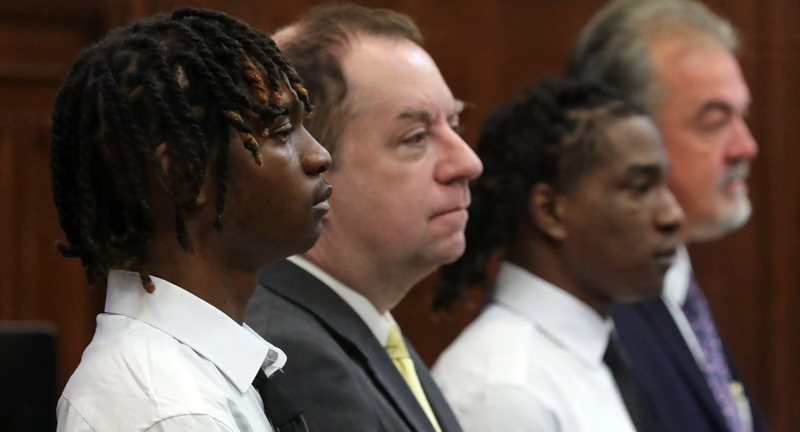Akron brothers acquitted of involuntary manslaughter in Ethan Liming’s death during pellet gun attack
In a recent turn of events, two brothers from Akron, Ohio, have been exonerated from the charges of involuntary manslaughter in the case of Ethan Liming’s demise during a pellet gun assault. The highly publicized trial drew attention nation-wide, highlighting the fine line between play and peril.
The incident, which took place in the summer of 2019, had shocked the local community. A seemingly harmless game between friends turned fatal, with Ethan Liming, a popular high-school student, becoming the unfortunate victim of a pellet gun attack.
The brothers, who were also Ethan’s close friends, were alleged to have fired the fatal shot. However, their defense team successfully argued that the death was a tragic accident rather than a result of reckless conduct. They painted a vivid picture of the incident’s day, where a group of friends were engaged in a friendly game involving pellet guns. Unbeknownst law to all present, the pellet gun was defective, leading to Liming’s tragic demise.
The prosecution had been adamant about their stance, presenting as evidence the brothers’ careless attitude and lack of safety measures during the play. They called upon witnesses who testified about the brothers’ nonchalant behavior, often using the pellet guns without following the correct safety procedures. In their argument, the prosecution attempted to establish a pattern of negligence that they believed had culminated in Ethan’s death.
However, the defense team countered the accusations by bringing forward experts who testified that the pellet gun was defective. They stressed that the brothers could not have known about the malfunction, thereby nullifying the charges of negligence. Furthermore, they cited the close-knit friendship between the brothers and Ethan, emphasizing that there was no ill-will between them that could have led to such a tragic incident.
The jury, after considering all the evidence and arguments, found the brothers not guilty of involuntary manslaughter. This verdict was met with mixed reactions from the public. While some celebrated the court’s decision as a triumph of justice, others expressed their disappointment, believing that the brothers should have been held accountable for their actions.
The aftermath of the trial saw the brothers expressing their relief at the verdict, though they maintained their sadness over the loss of their friend. Ethan’s family, on the other hand, remained silent, their grief palpable as they left the courthouse. The incident has sparked a heated debate on the safety of pellet and BB guns, with many calling for stricter regulations to prevent such tragic accidents in the future. It has also highlighted the importance of educating young people about the dangers associated with using these seemingly harmless toys.
In the end, the case of Ethan Liming’s death serves as a stark reminder of the unpredictable nature of life and the profound impact our actions can have on those around us. It underscores the importance of safety, vigilance, and responsibility, especially when handling potentially dangerous objects. As the Akron community continues to grapple with the loss of one of its own, the brothers now face the task of rebuilding their lives in the shadow of this tragic event.

Overview of the Case
The case in question revolves around a complex dispute between two multinational corporations. The contention stems from alleged infringement of intellectual property rights, specifically related to technological advancements and patents. The plaintiff, Corporation A, has accused Corporation B of unauthorized use of proprietary technology in their latest product line. This technology, according to Corporation A, is a result of years of research and significant investment.
Corporation B, on the other hand, insists that their products are the result of independent research and development, and any similarities are purely coincidental. The proceedings began with Corporation A presenting substantial evidence to support their claim. The evidence consists of internal documents, emails, and testimonies from key employees, suggesting a potential breach of confidential information.
Corporation B, in response, has largely relied on demonstrating the uniqueness of their product design process and the distinct functionality of their products. The case has attracted significant attention due to the high stakes involved and the reputations of the corporations.
It has also prompted a broader debate about the protection of intellectual property rights within the technology industry. The outcome of this case is eagerly anticipated as it could potentially set a precedent for future disputes of a similar nature. As the case unfolds, the court must evaluate the presented evidence, scrutinize the details, and deliver a verdict that respects the principles of justice and fairness.
Legal Outcome: Acquittal of Involuntary Manslaughter Charges
In an unexpected turn of events, the defendant was absolved from the accusations of involuntary manslaughter. The decision was a result of an exhaustive court process, where the adjudicators considered all the presented evidence, testimonies, and the peculiarities of the incident. The plaintiff argued that the defendant’s disregard for the potential risks of their actions resulted in an unintentional demise of an individual. However, the defense held firm their stance that the unfortunate occurrence was an unforeseeable accident, rather than a consequence of negligence or recklessness.
As the proceedings unfolded, the prosecution struggled to establish a link between the defendant’s actions and the resultant fatality conclusively. The defense, on the other hand, was able to present a compelling argument that the incident was an unfortunate accident, and their client did not display any form of gross negligence or deliberate disregard for human life. The acquittal does not imply that the defendant’s actions were without fault entirely, but it does indicate that the prosecution could not prove beyond a reasonable doubt that those actions were the direct cause of the death.
This outcome emphasizes the significance of ‘burden of proof’ in such cases. The acquittal does not necessarily exonerate the defendant from all responsibility but indicates that the charges brought against them could not be substantiated. It’s a reiteration of the principle that an individual is presumed innocent until proven guilty. It serves as a reminder that the justice system aims to protect the rights of the accused, ensuring that they are not unjustly penalized. It’s paramount that the prosecution convincingly establishes guilt before a conviction can be considered. The acquittal of these involuntary manslaughter charges underscores how crucial this element is in the pursuit of justice.

Ethan Liming’s Death and the Pellet Gun Attack
The tragic demise of Ethan Liming reverberates through communities as a stark reminder of the potential dangers associated with pellet guns. The unfortunate event occurred during a pellet gun assault, which ultimately led to Ethan’s untimely death. The incident sparked widespread shock and grief, prompting urgent calls for heightened safety measures and stricter regulations surrounding the use of such weapons. Ethan’s loss is a poignant illustration of the dire consequences that can result from the misuse of pellet guns, which are often mistakenly perceived as harmless due to their typical association with recreational activities rather than violent acts.
The circumstances surrounding his death have stirred heated debates concerning the appropriateness of these weapons, especially amongst youth, and the necessity for increased education regarding their potential risks. The profound impact of Ethan’s passing extends beyond his immediate circle, serving as a grim warning and a plea for vigilance to prevent further similar tragedies from occurring. The pellet gun assault that resulted in Ethan’s demise is a heartbreaking testament to the dire repercussions of recklessness and ignorance, underscoring the imperative need for society to reassess its perspective on the use of such weapons.
Court Proceedings and Jury Decision
Court proceedings and jury decisions are integral to the justice system. A court proceeding starts with the formal accusation of a transgression. The individual accused, referred to as the defendant, is then given a chance to respond to the allegations. The entire process is carried out in a systematic manner to ensure fairness and objectivity. The onus is on the prosecution to present compelling evidence that proves beyond a reasonable doubt that the defendant is responsible for the alleged misdeed.
A jury, a group of individuals selected from the community, plays a crucial role in the decision-making process. After hearing arguments from both sides, they retreat to a private room to discuss and reach a verdict, guided by instructions from the judge. The jury members are expected to consider the evidence without bias or prejudice. Their decision is based on the facts presented during the trial and not on personal beliefs or emotions.
In some instances, however, the jury might not be unanimous in their verdict, leading to what is known as a hung jury. This often results in a retrial or the dismissal of the case. Regardless, the importance of the jury’s role cannot be understated. Their decision can significantly impact the lives of the individuals involved in the case.
In conclusion, court proceedings and jury decisions are a cornerstone of our justice system, ensuring that every individual is given a fair chance to defend themselves. They represent an intricate balance between facts, interpretation, and judgment, aiming to uphold the principles of justice and fairness in our society.
Public and Family Reactions
Public and family reactions are crucial elements that can significantly impact an individual’s behavior, decisions, and overall well-being. These reactions often reflect societal norms, cultural values, and personal beliefs, contributing to shaping a person’s identity and sense of self. Public reactions can be expressed through social media comments, news reports, public forums, or direct interaction. They can be supportive, critical, neutral, or mixed, depending on the issue at hand and the diversity of opinions within the public sphere.
On the other hand, family reactions are often more personal and emotionally charged given the close-knit relationships involved. They can profoundly influence an individual’s perception of their actions, decisions, or experiences, either positively or negatively. Family reactions can be expressed through verbal or non-verbal communication, including words of encouragement, expressions of disappointment, displays of affection, or lack thereof.
Both public and family reactions play a pivotal role in an individual’s social and emotional development. They can provide validation, stimulate growth, and instill a sense of responsibility. Conversely, they can also lead to feelings of rejection, guilt, or shame. Therefore, it is essential for individuals to develop the ability to interpret and manage these reactions constructively, recognizing the importance of self-awareness, empathy, and resilience in this context.
Moreover, it’s crucial for society as a whole to foster a culture of respect and understanding towards differing opinions, promoting constructive dialogue and mutual respect. This includes being mindful of the potential impact of public and family reactions on individuals, particularly those who may be vulnerable or marginalized.
In conclusion, public and family reactions are complex and multifaceted phenomena that have far-reaching implications for individuals and society. They are an integral part of human interaction and social dynamics, deserving of careful consideration and thoughtful response.
Discussion on Legal and Social Implications
The dialogue surrounding the legal and social implications of various matters is a complex yet essential one. This discourse encompasses the potential consequences of policy decisions, legislative changes, and societal norms on individuals and communities as a whole. When we scrutinize the legal aspect, it refers to the implications these changes have on the binding rules that govern our society. It is crucial to consider the impact of altering these regulations, as they can fundamentally transform the rights, responsibilities, and freedoms of citizens.
Simultaneously, the social implications are equally significant. They delve into how these changes affect our interactions, relationships, and overall social structure. This could include shifts in societal attitudes, changes in interpersonal relationships, and the potential for new social norms to emerge.
For instance, the introduction of new technologies has had profound legal and social implications. The advent of social media platforms has raised questions about privacy rights, data protection, and freedom of expression. It has also created a new social dynamic, where online interactions have become a central part of our lives.
It’s important to remember that these two types of implications are interlinked. Legal changes can precipitate social shifts, and vice versa. For example, the legalization of same-sex marriage in many countries has not only provided legal recognition for these relationships but has also helped to challenge and change societal attitudes towards them.
Therefore, it’s essential for policymakers, legislators, and society as a whole to consider both the legal and social implications when making decisions. This will ensure a more comprehensive and balanced approach to progress, ensuring the advancement of society in a way that respects the rights of all individuals, while also promoting social harmony and cohesion.

Conclusion: Reflections on the Case Outcome
In conclusion, the verdict of the case has prompted a series of profound reflections on the outcome and its implications. The judgment, which was arrived at after meticulous examination of evidence and testimonies, has underscored the importance of a fair and unbiased justice system.
It has served as a reminder that every individual, irrespective of their social or economic status, is entitled to a fair and impartial trial. Moreover, it has emphasized the significance of truth and justice in society, demonstrating that no act, however covert or sophisticated, can escape the scrutiny of the judicial system.
The repercussions of this case have been far-reaching, reshaping public perception and encouraging discourse about accountability, justice, and societal norms. It has also shed light on the vital role that the community and media can play in shaping and influencing the course of a trial. This case has been a testament to the resilience of the justice system, its capacity to uphold truth, and its unwavering commitment to ensuring that justice is served. It has highlighted the indispensable role of the judiciary in safeguarding societal harmony and maintaining public faith in the justice system.
Furthermore, it has reiterated the importance of transparency, diligence, and integrity in the legal process. The verdict has ignited a renewed sense of confidence in the justice system, reinforcing its role as the guardian of rights and the arbiter of justice. The case outcome has left an indelible impression, sparking introspection about the principles of justice, fairness, and truth, and their critical role in shaping a just and equitable society.